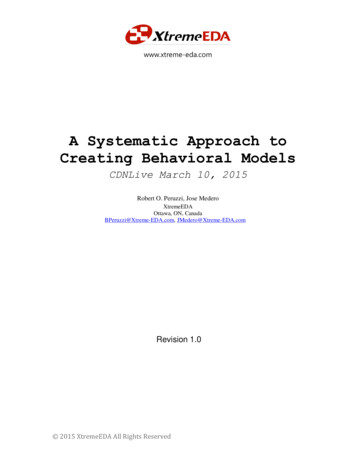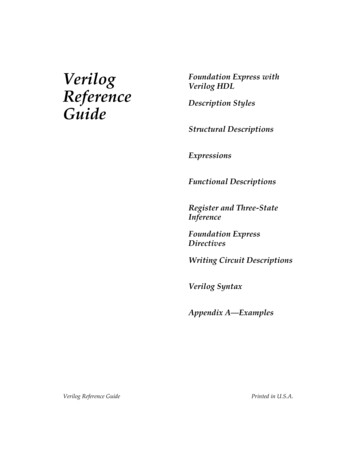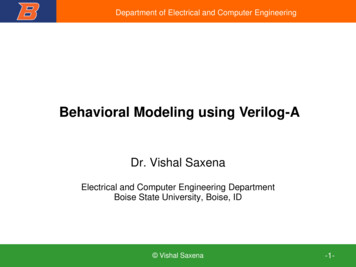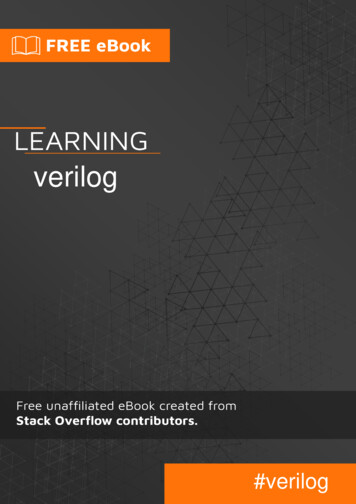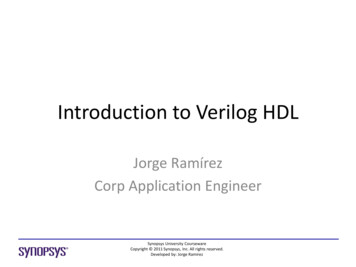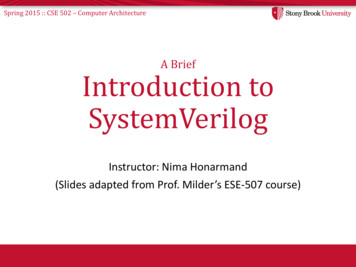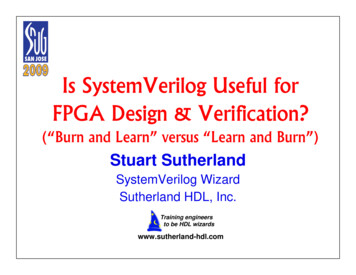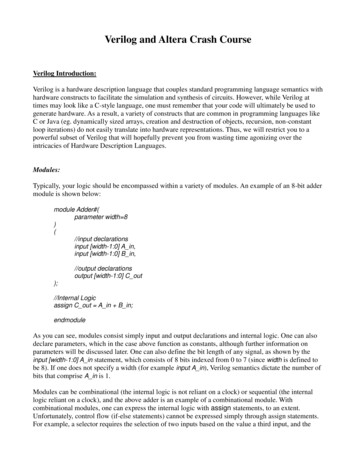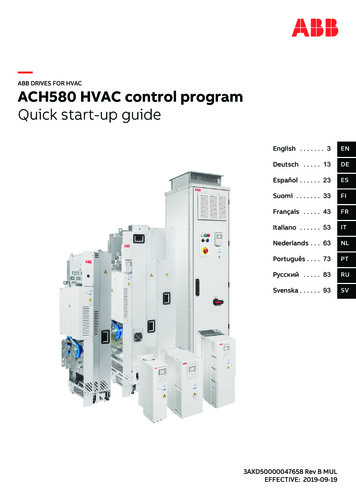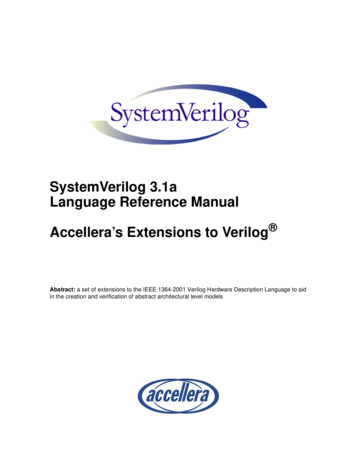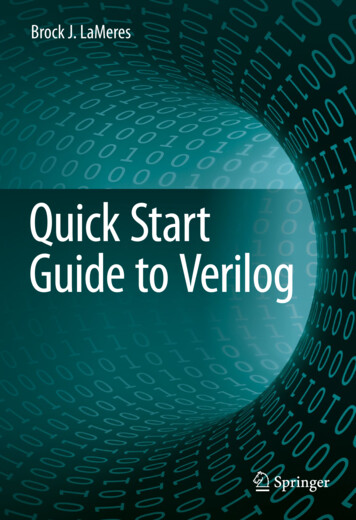
Transcription
Brock J. LaMeresQuick StartGuide to Verilog
QUICK START GUIDE TO VERILOG
QUICK START GUIDE TO VERILOG1 ST E DITIONBrock J. LaMeres
Brock J. LaMeresDepartment of Electrical & Computer EngineeringMontana State UniversityBozeman, MT, USAISBN 978-3-030-10551-8ISBN 978-3-030-10552-5 brary of Congress Control Number: 2018968403# Springer Nature Switzerland AG 2019This work is subject to copyright. All rights are reserved by the Publisher, whether the whole or part of the material isconcerned, specifically the rights of translation, reprinting, reuse of illustrations, recitation, broadcasting, reproductionon microfilms or in any other physical way, and transmission or information storage and retrieval, electronicadaptation, computer software, or by similar or dissimilar methodology now known or hereafter developed.The use of general descriptive names, registered names, trademarks, service marks, etc. in this publication does notimply, even in the absence of a specific statement, that such names are exempt from the relevant protective laws andregulations and therefore free for general use.The publisher, the authors, and the editors are safe to assume that the advice and information in this book are believedto be true and accurate at the date of publication. Neither the publisher nor the authors or the editors give a warranty,express or implied, with respect to the material contained herein or for any errors or omissions that may have beenmade. The publisher remains neutral with regard to jurisdictional claims in published maps and institutional affiliations.Cover credit: # MRMake j Dreamstime.com - Binary Code PhotoThis Springer imprint is published by the registered company Springer Nature Switzerland AGThe registered company address is: Gewerbestrasse 11, 6330 Cham, Switzerland
PrefaceThe classical digital design approach (i.e., manual synthesis and minimization of logic) quicklybecomes impractical as systems become more complex. This is the motivation for the modern digitaldesign flow, which uses hardware description languages (HDL) and computer-aided synthesis/minimization to create the final circuitry. The purpose of this book is to provide a quick start guide to the Veriloglanguage, which is one of the two most common languages used to describe logic in the modern digitaldesign flow. This book is intended for anyone that has already learned the classical digital designapproach and is ready to begin learning HDL-based design. This book is also suitable for practicingengineers that already know Verilog and need quick reference for syntax and examples of commoncircuits. This book assumes that the reader already understands digital logic (i.e., binary numbers,combinational and sequential logic design, finite state machines, memory, and binary arithmetic basics).Since this book is designed to accommodate a designer that is new to Verilog, the language ispresented in a manner that builds foundational knowledge first before moving into more complex topics.As such, Chaps. 1–6 provide a comprehensive explanation of the basic functionality in Verilog to modelcombinational and sequential logic. Chapters 7–11 focus on examples of common digital systems suchas finite state machines, memory, arithmetic, and computers. For a reader that is using the book as areference guide, it may be more practical to pull examples from Chaps. 7–11 as they use the fullfunctionality of the language as it is assumed the reader has gained an understanding of it inChaps. 1–6. For a Verilog novice, understanding the history and fundamentals of the language willhelp form a comprehensive understanding of the language; thus it is recommended that the earlychapters are covered in the sequence they are written.Bozeman, MT, USABrock J. LaMeresv
AcknowledgmentsFor Kylie. Your humor brings me laughter and happiness every day. Thank you.vii
Contents1: THE MODERN DIGITAL DESIGN FLOW .11.1 HISTORY OF HARDWARE DESCRIPTION LANGUAGES .1.2 HDL ABSTRACTION .1.3 THE MODERN DIGITAL DESIGN FLOW .1482: VERILOG CONSTRUCTS .132.1 DATA TYPES .2.1.1 Value Set .2.1.2 Net Data Types .2.1.3 Variable Data Types .2.1.4 Vectors .2.1.5 Arrays .2.1.6 Expressing Numbers Using Different Bases .2.1.7 Assigning Between Different Types .2.2 VERILOG MODULE CONSTRUCTION .2.2.1 The Module .2.2.2 Port Definitions .2.2.3 Signal Declarations .2.2.4 Parameter Declarations .2.2.5 Compiler Directives .13141415151616171718181920203: MODELING CONCURRENT FUNCTIONALITY IN VERILOG .233.1 VERILOG OPERATORS .3.1.1 Assignment Operator .3.1.2 Continuous Assignment .3.1.3 Bitwise Logical Operators .3.1.4 Reduction Logic Operators .3.1.5 Boolean Logic Operators .3.1.6 Relational Operators .3.1.7 Conditional Operators .3.1.8 Concatenation Operator .3.1.9 Replication Operator .3.1.10 Numerical Operators .3.1.11 Operator Precedence .3.2 CONTINUOUS ASSIGNMENT WITH LOGICAL OPERATORS .3.2.1 Logical Operator Example: SOP Circuit .3.2.2 Logical Operator Example: One-Hot Decoder .3.2.3 Logical Operator Example: 7-Segment Display Decoder .3.2.4 Logical Operator Example: One-Hot Encoder .3.2.5 Logical Operator Example: Multiplexer .3.2.6 Logical Operator Example: Demultiplexer .23232324252525262627272829293031343636ix
x Contents3.3 CONTINUOUS ASSIGNMENT WITH CONDITIONAL OPERATORS .3.3.1 Conditional Operator Example: SOP Circuit .3.3.2 Conditional Operator Example: One-Hot Decoder .3.3.3 Conditional Operator Example: 7-Segment Display Decoder .3.3.4 Conditional Operator Example: One-Hot Decoder .3.3.5 Conditional Operator Example: Multiplexer .3.3.6 Conditional Operator Example: Demultiplexer .3.4 CONTINUOUS ASSIGNMENT WITH DELAY .37383940404142434: STRUCTURAL DESIGN AND HIERARCHY .514.1 STRUCTURAL DESIGN CONSTRUCTS .4.1.1 Lower-Level Module Instantiation .4.1.2 Port Mapping .4.1.3 Gate-Level Primitives .4.1.4 User-Defined Primitives .4.1.5 Adding Delay to Primitives .4.2 STRUCTURAL DESIGN EXAMPLE: RIPPLE CARRY ADDER .4.2.1 Half Adders .4.2.2 Full Adders .4.2.3 Ripple Carry Adder (RCA) .4.2.4 Structural Model of a Ripple Carry Adder in Verilog .51515153545556565658595: MODELING SEQUENTIAL FUNCTIONALITY .655.1 PROCEDURAL ASSIGNMENT .5.1.1 Procedural Blocks .5.1.2 Procedural Statements .5.1.3 Statement Groups .5.1.4 Local Variables .5.2 CONDITIONAL PROGRAMMING CONSTRUCTS .5.2.1 if-else Statements .5.2.2 case Statements .5.2.3 casez and casex Statements .5.2.4 forever Loops .5.2.5 while Loops .5.2.6 repeat Loops .5.2.7 for Loops .5.2.8 disable .5.3 SYSTEM TASKS .5.3.1 Text Output .5.3.2 File Input/Output .5.3.3 Simulation Control and Monitoring .6565687373747475777777787879808081836: TEST BENCHES .896.1 TEST BENCH OVERVIEW .6.1.1 Generating Manual Stimulus .6.1.2 Printing Results to the Simulator Transcript .898991
Contents xi6.2 USING LOOPS TO GENERATE STIMULUS .6.3 AUTOMATIC RESULT CHECKING .6.4 USING EXTERNAL FILES IN TEST BENCHES .9395967: MODELING SEQUENTIAL STORAGE AND REGISTERS .1037.1 MODELING SCALAR STORAGE DEVICES .7.1.1 D-Latch .7.1.2 D-Flip-Flop .7.1.3 D-Flip-Flop with Asynchronous Reset .7.1.4 D-Flip-Flop with Asynchronous Reset and Preset .7.1.5 D-Flip-Flop with Synchronous Enable .7.2 MODELING REGISTERS .7.2.1 Registers with Enables .7.2.2 Shift Registers .7.2.3 Registers as Agents on a Data Bus .1031031031041051061071071081098: MODELING FINITE STATE MACHINES .1138.1 THE FSM DESIGN PROCESS AND A PUSH-BUTTON WINDOW CONTROLLER EXAMPLE .8.1.1 Modeling the States .8.1.2 The State Memory Block .8.1.3 The Next State Logic Block .8.1.4 The Output Logic Block .8.1.5 Changing the State Encoding Approach .8.2 FSM DESIGN EXAMPLES .8.2.1 Serial Bit Sequence Detector in Verilog .8.2.2 Vending Machine Controller in Verilog .8.2.3 2-Bit, Binary Up/Down Counter in Verilog .1131141151151161181191191211239: MODELING COUNTERS .1299.1 MODELING COUNTERS WITH A SINGLE PROCEDURAL BLOCK .9.1.1 Counters in Verilog Using the Type reg .9.1.2 Counters with Range Checking .9.2 COUNTER WITH ENABLES AND LOADS .9.2.1 Modeling Counters with Enables .9.2.2 Modeling Counters with Loads .12912913013113113110: MODELING MEMORY .13510.1 MEMORY ARCHITECTURE AND TERMINOLOGY .10.1.1 Memory Map Model .10.1.2 Volatile vs. Non-volatile Memory .10.1.3 Read-Only vs. Read/Write Memory .10.1.4 Random Access vs. Sequential Access .10.2 MODELING READ-ONLY MEMORY .10.3 MODELING READ/WRITE MEMORY .135135136136136137139
xii Contents11: COMPUTER SYSTEM DESIGN .14311.1 COMPUTER HARDWARE .11.1.1 Program Memory .11.1.2 Data Memory .11.1.3 Input/Output Ports .11.1.4 Central Processing Unit .11.1.5 A Memory Mapped System .11.2 COMPUTER SOFTWARE .11.2.1 Opcodes and Operands .11.2.2 Addressing Modes .11.2.3 Classes of Instructions .11.3 COMPUTER IMPLEMENTATION: AN 8-BIT COMPUTER EXAMPLE .11.3.1 Top-Level Block Diagram .11.3.2 Instruction Set Design .11.3.3 Memory System Implementation .11.3.4 CPU Implementation NDIX A: LIST OF WORKED EXAMPLES .187INDEX .189
Since this book is designed to accommodate a designer that is new to Verilog, the language is presented in a manner that builds foundational knowledge first before moving into more complex topics. As such, Chaps. 1–6 provide a comprehensive explanation of the basic functionality in Veri
